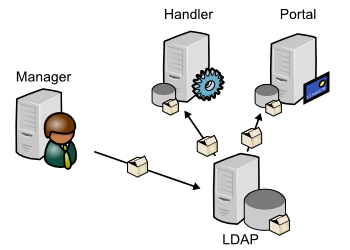Backend de configuration LDAP
Présentation
You can choose to store LemonLDAP::NG configuration in an LDAP directory.
Avantages :
- Easy to share between servers with remote LDAP access
- Easy to duplicate with LDAP synchronization services (like SyncRepl in OpenLDAP)
- Security with SSL/TLS
- Contrôle d'accès possible en créant un compte pour le manager (écriture) et un autre pour le portail et les agents (lecture)
- Import/export facilité via les fichiers LDIF
La configuration est stockée dans une branche spécifique, par exemple ou=conf,ou=applications,dc=example,dc=com.
Each configuration will be represented as an entry, which structural objectClass is by default applicationProcess. Le nom de la configuration est le même que pour File : lmConf-1, lmConf-2, etc... This name is used in entry DN, for example cn=lmConf-1,ou=conf,ou=applications,dc=example,dc=com.
Ensuite, chaque paramètre est une valeur de l'attribut description, prefixé par sa clef. Par exemple {ldapPort}389.
La vue LDIF d'une telle entrée ressemble à :
dn: cn=lmConf-1,ou=conf,ou=applications,dc=example,dc=com
objectClass: top
objectClass: applicationProcess
cn: lmConf-1
description: {globalStorage}'Apache::Session::File'
description: {cookieName}'lemonldap'
description: {whatToTrace}'$uid'
...
Configuration
Serveur LDAP
Les objets de configuration utilisent une classe d'objet standard : applicationProcess. Cet classe d'objet autorise les attributs cn et description. If your LDAP server do not manage this objectClass, configure other objectclass and attributes (see below).
We advice to create a specific LDAP account with write access on configuration branch.
Créer ensuite la branche des configurations n'importe où. Il faut juste retenir le DN pour la configuration de LemonLDAP::NG.
LemonLDAP::NG
Configure LDAP configuration backend in lemonldap-ng.ini, section [configuration]:
type = LDAP ldapServer = ldap://localhost ldapConfBase = ou=conf,ou=applications,dc=example,dc=com ldapBindDN = cn=manager,dc=example,dc=com ldapBindPassword = secret ldapObjectClass = applicationProcess ldapAttributeId = cn ldapAttributeContent = description
Paramètres:
- ldapServer: LDAP URI of the server
- ldapConfBase : DN de la branche des configurations
- ldapBindDN: DN used to bind LDAP
- ldapBindPassword: password used to bind LDAP
- ldapObjectClass: structural objectclass of configuration entry (optional)
- ldapAttributeId: RDN attribute of configuration entry (optional)
- ldapAttributeContent: attribute used to store configuration values, must be multivalued (optional)
